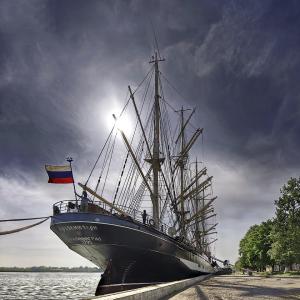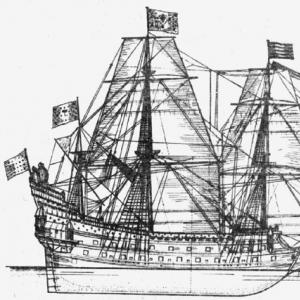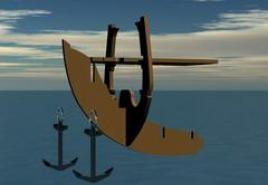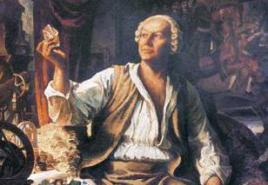Melting and solidification of crystalline bodies. Melting and solidification schedule
We present to your attention a video lesson on the topic “Melting and solidification of crystalline bodies. Melting and solidification schedule." Here we begin the study of a new broad topic: “Aggregative states of matter.” Here we will define the concept of a state of aggregation and consider examples of such bodies. And let’s look at what the processes in which substances pass from one state of aggregation to another are called and what they are. Let us dwell in more detail on the processes of melting and crystallization of solids and draw up a temperature graph of such processes.
Topic: Aggregate states of matter
Lesson: Melting and solidification of crystalline bodies. Melting and solidification schedule
Amorphous bodies- bodies in which atoms and molecules are ordered in a certain way only near the area under consideration. This type of arrangement of particles is called short-range order.
Liquids- substances without an ordered structure of particle arrangement, molecules in liquids move more freely, and intermolecular forces are weaker than in solids. The most important property: they retain volume, easily change shape and, due to their fluidity properties, take the shape of the vessel in which they are located (Fig. 3).
Rice. 3. The liquid takes the shape of a flask ()
Gases- substances whose molecules interact weakly with each other and move chaotically, often colliding with each other. The most important property: they do not retain volume and shape and occupy the entire volume of the vessel in which they are located.
It is important to know and understand how transitions between states of matter occur. We depict a diagram of such transitions in Figure 4.

1 - melting;
2 - hardening (crystallization);
3 - vaporization: evaporation or boiling;
4 - condensation;
5 - sublimation (sublimation) - transition from a solid to a gaseous state, bypassing the liquid;
6 - desublimation - transition from a gaseous state to a solid state, bypassing the liquid state.
In today's lesson we will pay attention to processes such as melting and solidification of crystalline bodies. It is convenient to begin considering such processes using the example of the most common melting and crystallization of ice in nature.
If you place ice in a flask and start heating it with a burner (Fig. 5), you will notice that its temperature will begin to rise until it reaches the melting temperature (0 o C), then the melting process will begin, but at the same time the temperature of the ice will not increase, and only after the process of melting all the ice is completed, the temperature of the resulting water will begin to increase.

Rice. 5. Ice melting.
Definition.Melting- the process of transition from solid to liquid. This process occurs at a constant temperature.
The temperature at which a substance melts is called the melting point and is a measured value for many solids, and therefore a tabular value. For example, the melting point of ice is 0 o C, and the melting point of gold is 1100 o C.
The reverse process to melting - the process of crystallization - is also conveniently considered using the example of freezing water and turning it into ice. If you take a test tube with water and start cooling it, you will first observe a decrease in the temperature of the water until it reaches 0 o C, and then it freezes at a constant temperature (Fig. 6), and after complete freezing, further cooling of the formed ice.

Rice. 6. Freezing of water.
If the described processes are considered from the point of view of the internal energy of the body, then during melting all the energy received by the body is spent on destroying the crystal lattice and weakening intermolecular bonds, thus, energy is spent not on changing temperature, but on changing the structure of the substance and the interaction of its particles. During the process of crystallization, energy exchange occurs in the opposite direction: the body gives off heat to the environment, and its internal energy decreases, which leads to a decrease in the mobility of particles, an increase in the interaction between them and solidification of the body.
It is useful to be able to graphically depict the processes of melting and crystallization of a substance on a graph (Fig. 7).

The axes of the graph are: the abscissa axis is time, the ordinate axis is the temperature of the substance. As the substance under study, we will take ice at a negative temperature, i.e., ice that, upon receiving heat, will not immediately begin to melt, but will be heated to the melting temperature. Let us describe the areas on the graph that represent individual thermal processes:
Initial state - a: heating of ice to a melting point of 0 o C;
a - b: melting process at a constant temperature of 0 o C;
b - a point with a certain temperature: heating the water formed from ice to a certain temperature;
A point with a certain temperature - c: cooling of water to a freezing point of 0 o C;
c - d: the process of freezing water at a constant temperature of 0 o C;
d - final state: cooling of ice to a certain negative temperature.
Today we looked at various states of matter and paid attention to processes such as melting and crystallization. In the next lesson we will discuss the main characteristic of the process of melting and solidification of substances - the specific heat of fusion.
1. Gendenshtein L. E., Kaidalov A. B., Kozhevnikov V. B. /Ed. Orlova V. A., Roizena I. I. Physics 8. - M.: Mnemosyne.
2. Peryshkin A.V. Physics 8. - M.: Bustard, 2010.
3. Fadeeva A. A., Zasov A. V., Kiselev D. F. Physics 8. - M.: Education.
1. Dictionaries and encyclopedias on Academician ().
2. Course of lectures “Molecular physics and thermodynamics” ().
3. Regional collection of the Tver region ().
1. Page 31: questions No. 1-4; page 32: questions No. 1-3; page 33: exercises No. 1-5; page 34: questions No. 1-3. Peryshkin A.V. Physics 8. - M.: Bustard, 2010.
2. A piece of ice floats in a pan of water. Under what condition will it not melt?
3. During melting, the temperature of the crystalline body remains unchanged. What happens to the internal energy of the body?
4. Experienced gardeners, in the event of spring night frosts during the flowering of fruit trees, water the branches generously in the evening. Why does this significantly reduce the risk of losing future crops?
As the temperature decreases, a substance can change from a liquid to a solid state.
This process is called solidification or crystallization.
When a substance solidifies, the same amount of heat is released, which is absorbed when it melts.

The calculation formulas for the amount of heat during melting and crystallization are the same.

The melting and solidification temperatures of the same substance, if the pressure does not change, are the same.
Throughout the entire crystallization process, the temperature of the substance does not change, and it can simultaneously exist in both liquid and solid states.
LOOK AT THE BOOKSHELF
INTERESTING ABOUT CRYSTALLIZATION
Colored ice?
If you add a little paint or tea leaves to a plastic glass of water, stir and, having obtained a colored solution, wrap the glass on top and expose it to frost, then a layer of ice will begin to form from the bottom to the surface. However, don't expect to get colorful ice!

Where the water began to freeze, there will be an absolutely transparent layer of ice. Its upper part will be colored, and even stronger than the original solution. If the concentration of paint was very high, then a puddle of its solution may remain on the surface of the ice.
The fact is that transparent fresh ice forms in solutions of paint and salts, because... growing crystals displace any extraneous atoms and impurity molecules, trying to build an ideal lattice as long as possible. Only when the impurities have nowhere to go does the ice begin to incorporate them into its structure or leave them in the form of capsules with concentrated liquid. Therefore, sea ice is fresh, and even the dirtiest puddles are covered with transparent and clean ice.
At what temperature does water freeze?
Is it always at zero degrees?
But if you pour boiled water into an absolutely clean and dry glass and place it outside the window in the cold at a temperature of minus 2-5 degrees C, covering it with clean glass and protecting it from direct sunlight, then after a few hours the contents of the glass will cool below zero, but will remain liquid.
If you then open a glass and throw a piece of ice or snow or even just dust into the water, then literally before your eyes the water will instantly freeze, sprouting long crystals throughout the entire volume.
Why?
The transformation of a liquid into a crystal occurs primarily on impurities and inhomogeneities - dust particles, air bubbles, irregularities on the walls of the vessel. Pure water has no centers of crystallization, and it can become supercooled while remaining liquid. In this way it was possible to bring the water temperature to minus 70°C.
How does this happen in nature?
In late autumn, very clean rivers and streams begin to freeze from the bottom. Through the layer of clean water it is clearly visible that the algae and driftwood at the bottom are overgrown with a loose coat of ice. At some point, this bottom ice floats up, and the surface of the water instantly becomes bound by an ice crust.
The temperature of the upper layers of water is lower than the deep ones, and freezing seems to begin from the surface. However, clean water freezes reluctantly, and ice primarily forms where there is a suspension of silt and a hard surface - near the bottom.
Downstream from waterfalls and dam spillways, a spongy mass of inland ice often appears, growing in the foaming water. Rising to the surface, it sometimes clogs the entire riverbed, forming so-called jams, which can even dam the river.
Why is ice lighter than water?
Inside the ice there are many pores and spaces filled with air, but this is not the reason that can explain the fact that ice is lighter than water. Ice and without microscopic pores
still has a density less than that of water. It's all about the peculiarities of the internal structure of ice. In an ice crystal, water molecules are located at the nodes of the crystal lattice so that each has four “neighbors.”
Water, on the other hand, does not have a crystalline structure, and the molecules in the liquid are located closer together than in the crystal, i.e. water is denser than ice.
At first, when ice melts, the released molecules still retain the structure of the crystal lattice, and the density of water remains low, but gradually the crystal lattice is destroyed, and the density of water increases.
At a temperature of + 4°C, the density of water reaches a maximum, and then begins to decrease with increasing temperature due to an increase in the speed of thermal movement of molecules.
How does a puddle freeze?
When cooling, the upper layers of water become denser and sink down. Their place is taken by denser water. This mixing occurs until the water temperature drops to +4 degrees Celsius. At this temperature, the density of water is maximum.
With a further decrease in temperature, the upper layers of water can become more compressed, and gradually cooling to 0 degrees, the water begins to freeze.

In autumn, the air temperature at night and during the day is very different, so the ice freezes in layers.
The bottom surface of the ice on a freezing puddle is very similar to a cross section of a tree trunk:
concentric rings are visible. The width of the ice rings can be used to judge the weather. Usually the puddle begins to freeze from the edges, because... there is less depth there. The area of the resulting rings decreases as they approach the center.
INTERESTING
That in the pipes of the underground part of buildings, water often freezes not in frost, but in thaw!
This is due to poor thermal conductivity of the soil. Heat passes through the ground so slowly that the minimum temperature in the soil occurs later than at the surface of the earth. The deeper, the greater the delay. Often during frosts the soil does not have time to cool, and only when a thaw occurs on the ground does frost reach underground.
That when water freezes in a sealed bottle, it breaks it. What happens to a glass if you freeze water in it? When water freezes, it will expand not only upward, but also to the sides, and the glass will shrink. This will still lead to the destruction of the glass!
DID YOU KNOW
There is a known case when the contents of a well-chilled bottle of Narzan in the freezer, opened on a hot summer day, instantly turned into a piece of ice.
The metal “cast iron” behaves interestingly, which expands during crystallization. This allows it to be used as a material for the artistic casting of thin lace lattices and small tabletop sculptures. After all, when it hardens, expanding, cast iron fills everything, even the thinnest details of the mold.
In the Kuban in winter they prepare strong drinks - “vymorozki”. To do this, the wine is exposed to frost. The water freezes first, leaving a concentrated alcohol solution. It is drained and the operation is repeated until the desired strength is achieved. The higher the alcohol concentration, the lower the freezing point.
The largest hailstone recorded by humans fell in Kansas, USA. Its weight was almost 700 grams.
Oxygen in a gaseous state at a temperature of minus 183 degrees C turns into liquid, and at a temperature of minus 218.6 degrees C, solid oxygen is obtained from liquid

In the old days, people used ice to store food. Carl von Linde created the first home refrigerator, powered by a steam engine that pumped freon gas through pipes. Behind the refrigerator, the gas in the pipes condensed and turned into liquid. Inside the refrigerator, liquid freon evaporated and its temperature dropped sharply, cooling the refrigerator compartment. Only in 1923, Swedish inventors Balzen von Platen and Karl Muntens created the first electric refrigerator, in which freon turns from a liquid into a gas and takes heat from the air in the refrigerator.
THIS IS YES
Several pieces of dry ice thrown into burning gasoline extinguish the fire.
There is ice that would burn your fingers if you could touch it. It is obtained under very high pressure, at which water turns into a solid state at a temperature well above 0 degrees Celsius.
Any element can be in several different states, subject to some external conditions. Melting and solidification of crystalline bodies are the main changes in the structure of materials. A good example is water, which can exist in liquid, gaseous and solid states. These different forms are called aggregate (from the Greek “I bind”) states. The state of aggregation is the forms of one element, differing in the nature of the arrangement of particles (atoms), which do not change their structure.
In contact with
How changes happen
There are several processes that characterize changing forms different substances:
- hardening;
- boiling;
- (from solid form immediately to gaseous);
- evaporation;
- fuse;
- condensation;
- desublimation (reverse transition from sublimation).
Each transformation is characterized by certain conditions that must be met for a successful transition.
Formulas
What process is called thermal? Any in which a change in the aggregate state of materials occurs, since temperature plays a large role in them. Any thermal change has its opposite: from liquid to solid and vice versa, from solid to vapor and vice versa.
Important! Almost all thermal processes are reversible.
There are formulas that can be used to determine what the specific heat will be, that is, the heat required to change 1 kg of solid.
For example, the formula for solidification and melting is: Q=λm, where λ is the specific heat.
But the formula for displaying the process of cooling and heating is Q = cmt, where c is the specific heat capacity - the volume of heat to heat 1 kg of material by one degree, m is the mass, and t is the temperature difference.
Formula for condensation and vaporization: Q=Lm, where specific heat is L, and m is mass.
Description of processes
Melting is one of the ways to deform a structure, transfer from solid to liquid. It occurs almost the same in all cases, but in two different ways:
- the element is heated externally;
- heating occurs from the inside.
These two methods differ in their instruments: in the first case, substances are heated in a special furnace, and in the second, current is passed through the object or it is inductively heated by placing it in an electromagnetic field with high frequencies.
Important! The destruction of the crystalline structure of the material and the occurrence of changes in it leads to the liquid state of the element.
Using different tools you can achieve the same process:
- temperature rises;
- the crystal lattice changes;
- particles move away from each other;
- other disturbances of the crystal lattice appear;
- interatomic bonds are broken;
- a quasi-liquid layer is formed.
As has already become clear, temperature is the main factor due to which the state of the element changes. The melting point is divided into:
- light - no more than 600°C;
- medium - 600-1600°C;
- tight – over 1600°C.
 The tool for this work is chosen according to its membership in one group or another: the more the material needs to be heated, the more powerful the mechanism should be.
The tool for this work is chosen according to its membership in one group or another: the more the material needs to be heated, the more powerful the mechanism should be.
However, you should be careful and check the data with the coordinate system, for example, the critical temperature of solid mercury is -39°C, and that of solid alcohol is -114°C, but the larger of them will be -39°C, since according to the coordinate system this is the number closer to zero.
An equally important indicator is the boiling point, at which liquid boils. This value is equal to the heat of vapor formed above the surface. This indicator is directly proportional to pressure: as pressure increases, the melting point increases and vice versa.
Auxiliary materials
Each material has its own temperature indicators at which its shape changes, and for each of them you can create your own melting and solidification schedule. Depending on the crystal lattice, the indicators will vary. For example, ice melting graph shows that it requires very little heat, as shown below:
The graph shows the relationship between the amount of heat (vertical) and time (horizontal) required to melt ice.
The table shows the quantities needed to melt the most common metals.
A melting chart and other auxiliary materials are extremely necessary during experiments in order to track changes in the position of particles and notice the beginning of changes in the shape of elements.
Solidification of bodies
Hardening is changing the liquid form of an element into a solid one. A necessary condition is that the temperature drop below freezing point. During this procedure, a crystalline structure of molecules can be formed, and then the change in state is called crystallization. In this case, the element in liquid form must cool to the temperature of solidification or crystallization.
 Melting and solidification of crystalline bodies occurs under the same environmental conditions: crystallizes at 0 °C, and ice melts at the same temperature.
Melting and solidification of crystalline bodies occurs under the same environmental conditions: crystallizes at 0 °C, and ice melts at the same temperature.
And in the case of metals: iron required 1539°C for melting and crystallization.
Experience proves that in order for a substance to solidify, it must release an equal amount of heat as during the reverse transformation.
The molecules are attracted to each other, forming a crystal lattice, unable to resist as they lose their energy. Thus, specific heat determines how much energy is needed to transform a body into a liquid state and how much of it is released during solidification.
Curing formula - this is Q = λ*m. During crystallization, a minus sign is added to the Q sign, since the body in this case releases or loses energy.
We study physics - graphs of melting and solidification of substances
Crystal melting and solidification processes
Conclusion
All these indicators of thermal processes must be known for a deep comprehension of physics and understanding of primitive natural processes. It is necessary to explain them to students as early as possible, using available tools as examples.
Much attention was paid to the mutual transformations of liquids and gases. Now consider the transformation of solids into liquids and liquids into solids.
Melting of crystalline bodies
Melting is the transformation of a substance from a solid to a liquid.
There is a significant difference between the melting of crystalline and amorphous solids. In order for a crystalline body to begin to melt, it must be heated to a temperature that is quite specific for each substance, called the melting point.
For example, at normal atmospheric pressure the melting point of ice is 0 °C, naphthalene - 80 °C, copper - 1083 °C, tungsten - 3380 °C.
For a body to melt, it is not enough to heat it to the melting temperature; it is necessary to continue to supply heat to it, i.e., to increase its internal energy. During melting, the temperature of the crystalline body does not change.
If a body continues to be heated after it has melted, the temperature of its melt will increase. This can be illustrated by a graph of the dependence of body temperature on the time of its heating (Fig. 8.27). Plot AB corresponds to heating of a solid, horizontal section Sun- melting process and area CD - heating the melt. Curvature and slope of graph sections AB And CD depend on the process conditions (mass of the heated body, heater power, etc.).
The transition of a crystalline body from a solid to a liquid state occurs abruptly, abruptly - either a liquid or a solid.
Melting of amorphous bodies
This is not how amorphous bodies behave at all. When heated, they gradually soften as the temperature rises and eventually become liquid, remaining homogeneous throughout the entire heating time. There is no specific temperature for the transition from solid to liquid. Figure 8.28 shows a graph of temperature versus time during the transition of an amorphous body from solid to liquid.

Solidification of crystalline and amorphous bodies
The transition of a substance from a liquid to a solid state is called solidification or crystallization(for crystalline bodies).
There is also a significant difference between the solidification of crystalline and amorphous bodies. When a molten crystalline body (melt) is cooled, it continues to remain in a liquid state until its temperature drops to a certain value. At this temperature, called the crystallization temperature, the body begins to crystallize. The temperature of the crystalline body does not change during solidification. Numerous observations have shown that Crystalline bodies melt and solidify at the same temperature determined for each substance. With further cooling of the body, when the entire melt has solidified, the body temperature will decrease again. This is illustrated by a graph of the dependence of body temperature on the time of its cooling (Fig. 8.29). Plot A 1 IN 1 corresponds to liquid cooling, horizontal section IN 1 WITH 1 - crystallization process and area C 1 D 1 - cooling of the solid resulting from crystallization.

Substances also transition from liquid to solid during crystallization abruptly without intermediate states.
Hardening of an amorphous body, such as resin, occurs gradually and equally in all its parts; the resin remains homogeneous, i.e. the hardening of amorphous bodies is only a gradual thickening of them. There is no specific curing temperature. Figure 8.30 shows a graph of the temperature of the curing resin versus time.

Thus, amorphous substances do not have a certain temperature, melting and solidification.







